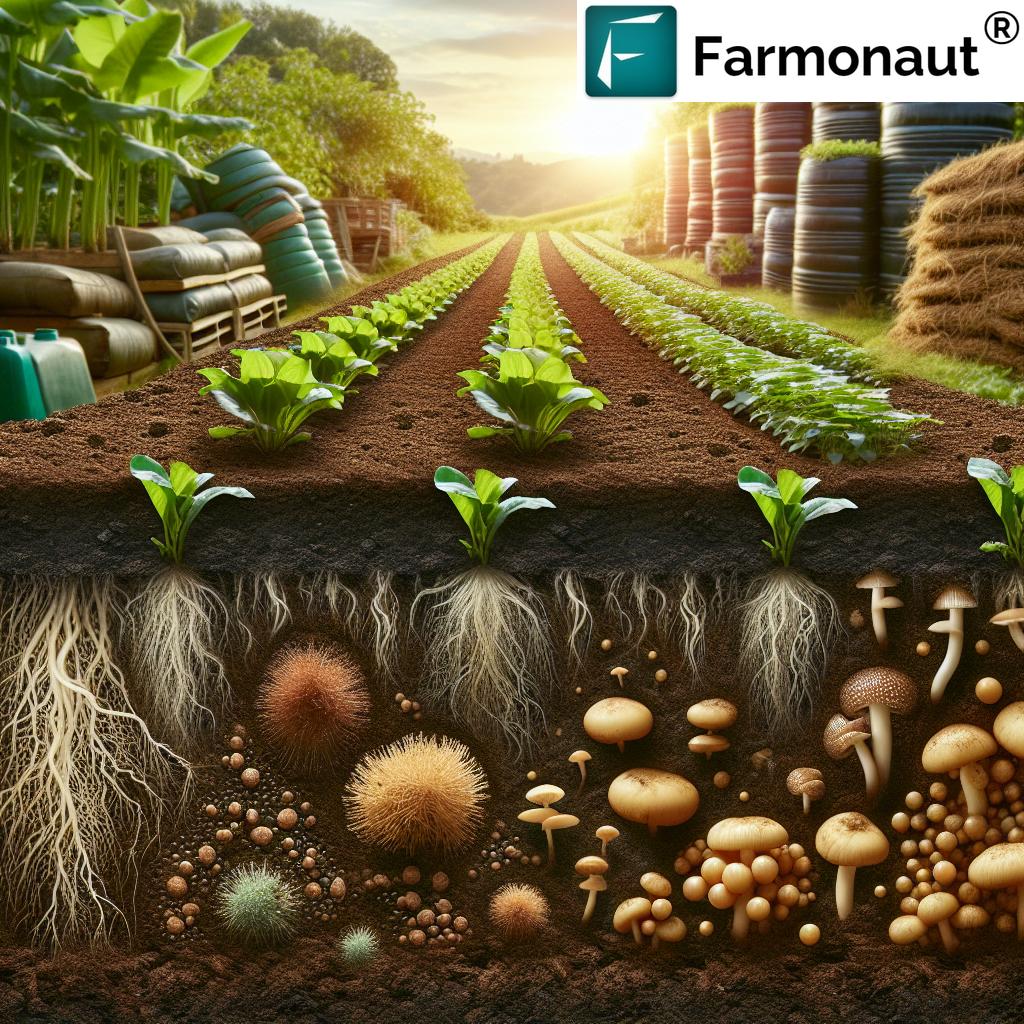Biofertilizers in Organic Farming: 7 Soil Boosting Tips
“Biofertilizers can increase crop yields by up to 30% compared to conventional chemical fertilizers in organic farming.”
Welcome to our comprehensive guide on biofertilizers in organic farming—where we dive deep into the natural secrets of soil health, the science-backed ways to increase crop yield organically, and the sustainable practices every grower should know. As we collectively seek to reduce our reliance on synthetic fertilizers and move towards environmentally friendly fertilizers, biofertilizers are emerging as the cornerstone of sustainable agriculture practices worldwide.
Understanding Biofertilizers in Organic Farming
The essence of organic farming lies in maintaining ecological balance and supporting soil vitality through natural processes. At the core of this philosophy are biofertilizers—living inputs that profoundly enhance of soil fertility and increase plant growth without the environmental drawbacks associated with synthetic fertilizers.
Biofertilizers are substances containing living microorganisms which, when applied to seeds, plant surfaces, or soil, colonize the rhizosphere or plant interior, making primary nutrients more available to crops. Unlike chemical fertilizers, biofertilizers restore the soil’s natural nutrient cycle, increase organic matter, and help us promote biodiversity.
The fundamental mechanisms through which biofertilizers work include:
- Fixing atmospheric nitrogen into plant-accessible forms
- Solubilizing unavailable phosphorus and potassium compounds
- Decomposing organic matter and producing growth-promoting substances
- Enhancing microbial diversity and soil quality
Types of Biofertilizers and Their Roles in Soil Fertility Enhancement
Comprehending the types of biofertilizers and their function in soil fertility enhancement helps us make better choices for organic farming. Let’s break down the key microorganisms and their specific benefits:
- Nitrogen-Fixing Biofertilizers: Featuring Rhizobium, Azotobacter, and Azospirillum—these bacteria convert atmospheric nitrogen into plant-accessible forms, especially benefiting leguminous and non-leguminous crops alike. Often referred to as nitrogen fixing bacteria in agriculture.
- Phosphate-Solubilizing Microorganisms: Bacillus, Pseudomonas and allied species convert insoluble phosphorus into forms accessible to plants, addressing one of the most common nutrient bottlenecks in soils.
- Mycorrhizal Fungi: Arbuscular mycorrhizal fungi (AMF) form symbiotic associations with plant roots, mobilizing phosphorus and zinc, boosting water uptake, and improving stress resilience. They are crucial in mycorrhizal fungi in crop production.
- Potassium-Mobilizing Biofertilizers: Specialized strains of bacteria mobilize potassium to help plants access this essential nutrient for growth, yield, and disease resistance.
- Organic Matter Decomposers: Microorganisms like Trichoderma and Bacillus species, which help decompose organic matter, enrich the soil with nutrients, and foster beneficial microbial activity.
Key Focus Areas
- Biofertilizers for organic farming aim to replace or reduce chemical fertilizer use
- They utilize beneficial microorganisms to boost plant nutrient uptake
- They are central to sustainable agriculture practices
Comparison Table: Types of Biofertilizers, Application Methods & Environmental Benefits
| Type of Biofertilizer | Key Microorganisms | Estimated Increase in Soil Fertility (%) | Suitable Crops | Recommended Application Method | Environmental Impact |
|---|---|---|---|---|---|
| Rhizobium | Rhizobium spp. | 20–25% | Legumes (pea, bean, chickpea, lentil) | Seed inoculation, soil application | Reduces chemical use, increases organic nitrogen |
| Azospirillum | Azospirillum spp. | 10–20% | Cereals, oilseeds, vegetables | Seed/soil treatment | Boosts soil N, improves structure |
| Azotobacter | Azotobacter spp. | 10–15% | Cereals, cotton, vegetables | Soil application, seed treatment | Heightens free-living nitrogen fixation |
| Phosphobacteria / PSB | Bacillus, Pseudomonas | 10–18% | All crops | Soil/seed application | Solubilizes locked phosphorus, lessens fertilizer need |
| Blue-Green Algae (BGA) | Anabaena, Nostoc, Oscillatoria | 15–25% | Paddy rice | Water/soil inoculation | Enhances N cycles, water quality |
| Mycorrhiza (AMF) | Glomus, Sclerocystis, Gigaspora | 10–22% | All crops, especially horticulture | Soil/root inoculant | Increases nutrient uptake, improves soil biodiversity |
| Compost Decomposers | Trichoderma, Bacillus | 12–16% | All crops (soil amendment) | Compost enrichment, soil incorporation | Speeds matter breakdown, enriches organic content |
7 Soil Boosting Tips: Getting the Most Out of Biofertilizers for Organic Farming
-
Know Your Soil and Crop Needs
Begin with a soil test and crop assessment. Recognize if your soil is deficient in nutrients such as nitrogen, phosphorus, or potassium. Match the biofertilizer type (e.g., mycorrhizal fungi for horticultural crops or Rhizobium for legumes) to your crop and soil requirements for optimal nutrient availability.
-
Choose Quality Biofertilizer Products
Ensure the biofertilizer contains viable, active microorganisms, ideally verified by certification. Proper storage (cool, dry places away from sunlight) is crucial for their effectiveness and shelf life. Always check expiry dates and avoid exposure to chemicals or contaminated water during use.
-
Use the Right Application Method at the Right Time
Depending on the crop and target result, apply via seed treatment, root dipping, soil incorporation, or foliar spray. For example, seed coating with Rhizobium before sowing legumes encourages early symbiotic relationships, while soil application of phosphate-solubilizing microorganisms (PSB) makes phosphorus available to roots as plants grow.
-
Rotate Crops and Integrate Green Manures
Diversify crops and integrate green manures (legumes) to maintain soil health and stimulate ongoing microbial activity. This practice helps maintain the soil’s natural nutrient cycle and supports the action of biofertilizers.
-
Improve Organic Matter Inputs
Regularly add compost, crop residues, or farmyard manure to supply organic matter—fuel for biofertilizer microorganisms. This enhances decomposition, increases soil carbon, and helps beneficial bacteria and fungi thrive.
-
Monitor Soil Moisture and pH
Biofertilizer effectiveness depends on favorable environmental conditions. Maintain adequate moisture and a pH that supports microbial activity (generally 6–7.5 for most bacteria and fungi). Avoid waterlogging or extreme acidity/alkalinity, as this harms microorganisms.
-
Reduce or Avoid Chemical Inputs
Excessive use of synthetic chemicals—herbicides, pesticides, or chemical fertilizers—can disrupt beneficial microbial populations. Use environmentally friendly fertilizers and biocontrol agents (e.g., Trichoderma) to protect both soil fertility and the ecological balance of your farm.
“Over 60% of organic farmers use biofertilizers to sustainably enhance soil fertility and reduce environmental impact.”
Application Methods of Biofertilizers in Organic Farming
Proper application of biofertilizers ensures maximum benefit to both plants and soil. Key approaches include:
- Seed Treatment: Coat seeds with biofertilizer solution just before sowing. This promotes the early colonization of roots by beneficial microbes.
- Soil Application: Mix biofertilizer with compost or soil and apply to fields, supporting overall soil fertility enhancement.
- Foliar Spray: Dilute liquid biofertilizer and spray onto plant leaves to aid nutrient absorption and growth.
- Root Dipping: Dip roots of seedlings in a biofertilizer slurry before transplantation. This establishes beneficial microorganisms at the root zone, improving initial growth and stress resistance.
For best results, always follow label instructions provided by certified sources, avoid mixing with chemical fertilizers, and apply under optimal conditions of soil moisture and temperature.
Benefits of Biofertilizers: Enhancing Soil Health, Crop Yield, and Environmental Sustainability
Why should we use biofertilizers for organic farming? Their advantages span agronomy, economics, and environmental health:
- Eco-Friendly & Biodegradable: They help maintain ecological balance by restoring natural cycles, reducing pollution, and improving soil structure.
- Cost Effective: Lower input costs due to reduced need for chemical fertilizers and improved long-term productivity.
- Enhanced Soil Fertility & Quality: Increase organic matter, boost microbial diversity, and improve nutrient cycling, making nutrient forms more accessible to plants.
- Increased Crop Yield & Quality: Crops demonstrate higher yields, improved nutritional quality, and greater resilience to stress when grown organically with biofertilizers.
- Improved Disease Resistance: Certain strains, like Trichoderma, act as natural biocontrol agents, suppressing soil-borne pathogens.
- Supports Carbon Footprinting and Climate Resilience: By increasing soil organic carbon, biofertilizers contribute to climate-smart agriculture and help farmers track and reduce carbon outputs—a feature supported by Farmonaut’s carbon footprint tracking tools.
Challenges and Limitations of Using Biofertilizers
While biofertilizers for organic farming deliver impressive long-term gains, several limitations should be considered:
- Slower Results: As these work with natural processes and microbial activity, results may take longer to become visible versus chemical fertilizers.
- Storage Handling & Shelf Life: Containing living microorganisms, biofertilizers must be used before expiry dates and stored away from sunlight and chemicals to remain effective.
- Specificity of Action: Some strains are crop or soil-specific, so choosing the right type is key for success.
- Environmental Sensitivity: Factors like temperature, moisture, and soil pH greatly affect their performance. Maintaining favorable conditions is crucial.
- Limited Shelf Life vs. Chemical Options: Unlike synthetic fertilizers, biofertilizers can’t be stockpiled indefinitely, necessitating more frequent procurement and monitoring.
Careful planning, appropriate crop rotations, and proper management routines help mitigate these constraints.
Looking to integrate precision technology with your organic farm? Try Farmonaut’s Large Scale Farm Management Tools for tailored crop monitoring, soil health mapping, and actionable insights!
Interested in crop traceability and sustainability reporting for your organic harvests? Explore Farmonaut’s Blockchain-Based Product Traceability.
Leverage API-driven satellite data and real-time crop monitoring APIs to supercharge your organic farm data. See the developer documentation for easy API integration.
Integrating Technology: How Farmonaut Powers Sustainable Agriculture Practices
As we move towards smarter farming, the integration of advanced technologies with biofertilizer-driven organic practices leads to new levels of precision and sustainability. Farmonaut provides satellite-based crop health monitoring, soil and vegetation indices (NDVI), soil moisture analytics, and resource management—tools that enable us to:
- Track real-time soil health trends, nutrient distribution, and microbial activity areas across fields
- Receive actionable recommendations on irrigation and fertilizer use through the Jeevn AI Advisory System
- Audit and improve our farm’s sustainability record with carbon footprint tracking
- Access transparent, blockchain-based traceability—ensuring our organic products stay authentic through every supply chain stage
- Manage fleets and logistics for organic farm operations with fleet management solutions
All these tools are available via the Farmonaut web, Android, and iOS apps. With scalable subscription plans, we can adapt to changing farm needs and new sustainability goals without costly infrastructure.
FAQ: Biofertilizers in Organic Farming
What are biofertilizers?
Biofertilizers are living microbial inputs that, when applied to seeds, plants, or soil, increase the availability of nutrients by fixing nitrogen, solubilizing phosphorus, or decomposing organic matter.
How do biofertilizers differ from chemical fertilizers?
Unlike chemical fertilizers, which provide nutrients directly but may harm soil microbiota and cause pollution, biofertilizers rely on natural biological processes to enrich the soil and support ongoing fertility in a sustainable manner.
Which crops can benefit from biofertilizers?
All crops can benefit, including cereals, legumes, oilseeds, vegetables, and fruit crops, especially when specific biofertilizer types are matched to crop needs (e.g., Rhizobium for legumes, mycorrhizae for fruits and vegetables).
How should biofertilizers be applied?
Suggested methods include seed coating, soil application, foliar spraying, and root dipping (depending on the targeted benefit and crop type).
Do biofertilizers have a shelf life?
Yes, as they contain living microorganisms, biofertilizers must be used before expiry and require careful storage to remain effective.
Are biofertilizers essential for sustainable agriculture?
Yes. They are central to sustainable agriculture practices, playing a significant role in increasing crop yield organically and reducing environmental impact.
Conclusion: Growing a Sustainable and Bountiful Future With Biofertilizers in Organic Farming
By consistently using biofertilizers in organic farming, we help create resilient agricultural systems that restore soil health, improve yield quality, and sustain our planet for future generations. Leveraging satellite-driven platforms and precision management tools like Farmonaut further amplifies our ability to nurture soil, monitor plant growth, and make efficient, eco-friendly decisions.
Let’s commit to soil fertility enhancement through science-based techniques and data-driven sustainable practices. Together, we can cultivate a greener, healthier, and more productive world—rooted in the power of living soils and perennial biodiversity!
Start Optimizing Your Farm’s Soil Health with Farmonaut Today!


















